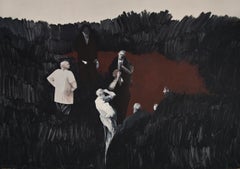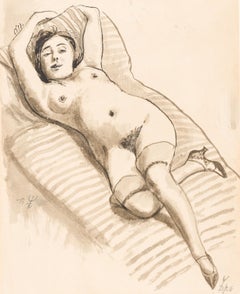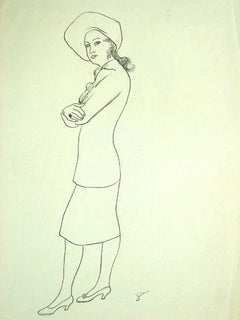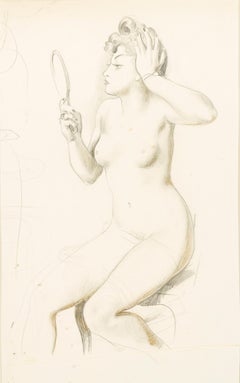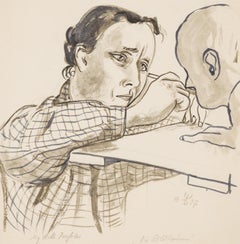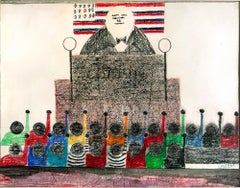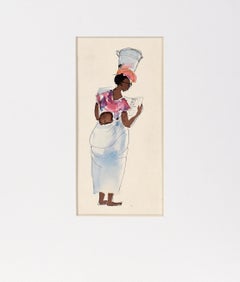Austria - Portrait Drawings and Watercolors
to
1
3
3
1
Overall Width
to
Overall Height
to
6
1
1
1
5
2
6
1
7
6
6
4
3
2
2
1
1
1
1
1
5
3
3
2
1
5
1
1
1
2,178
1,481
Item Ships From: Austria
Untitled 6 - Series Final Fantasy, Minutiae Contemporary Figurative Painting
By Magdalena Peszkowska
Located in Salzburg, AT
Magdalena Peszkowska born in 1980 in Gdańsk, Poland. Studied in Department of Painting at Academy of Fine Arts in Gdańsk (1999-2004). Diploma with special recognition in painting in 2004.
The cycle of ‘Final Fantasy...
Category
2010s Contemporary Austria - Portrait Drawings and Watercolors
Materials
Acrylic, Cardboard
Akt mit Strümpfen
By August Wilhelm Dressler
Located in Wien, 9
August Dressler is one of the painters of the New Objectivity. He is one of the lesser-known artists of the Weimar era, but he too, like his famous contemporaries Georg Grosz, John H...
Category
1920s Modern Austria - Portrait Drawings and Watercolors
Materials
Ink, Watercolor
Dame mit Hut
By August Wilhelm Dressler
Located in Wien, 9
August Dressler is one of the painters of the New Objectivity. He is one of the lesser-known artists of the Weimar era, but he too, like his famous contemporaries Georg Grosz, John H...
Category
20th Century Modern Austria - Portrait Drawings and Watercolors
Materials
Paper, Pencil
Akt mit Handspiegel
By August Wilhelm Dressler
Located in Wien, 9
August Dressler is one of the painters of the New Objectivity. He is one of the lesser-known artists of the Weimar era, but he too, like his famous contemporaries Georg Grosz, John H...
Category
20th Century Modern Austria - Portrait Drawings and Watercolors
Materials
Paper, Pencil
Die Bildhauerin
By August Wilhelm Dressler
Located in Wien, 9
August Dressler is one of the painters of the New Objectivity. He is one of the lesser-known artists of the Weimar era, but he too, like his famous contemporaries Georg Grosz, John H...
Category
20th Century Modern Austria - Portrait Drawings and Watercolors
Materials
Paper, Ink
Heroin
By Karl Anton Fleck
Located in Wien, 9
Karl Anton Fleck's portraits captivate through reduction to the essential, as well as distortion and the use of details and symbols. The striking stroke creates clear contours and th...
Category
1980s Contemporary Austria - Portrait Drawings and Watercolors
Materials
Paper, Graphite
Frau bei Tisch sitzend
By August Wilhelm Dressler
Located in Wien, 9
August Dressler is one of the painters of the New Objectivity. He is one of the lesser-known artists of the Weimar era, but he too, like his famous contemporaries Georg Grosz, John H...
Category
20th Century Modern Austria - Portrait Drawings and Watercolors
Materials
Paper, Ink
Related Items
Black Panther Trials - Civil Rights Movement Police Violence African American
Located in Miami, FL
The Black Panther Trials - In this historically significant work, African American Artist Vicent D. Smith functions as an Art Journalist/ Court Reporter as much as a
Artist. Here, he depicts, in complete unity, 21 Black Panther Protestors raising their fist of defiance at the White Judge. Smith's composition is about utter simplicity, where the Black Panther Protestors are symmetrically lined up in a confrontation with a Judge whose size is exaggerated in scale. Set against a stylized American Flag, the supercilious Judge gazes down as the protesters as their fists thrust up. Signed Vincent lower right. Titled Panter 21. Original metal frame. Tape on upper left edge of frame. 255 . Panther 21. Framed under plexi.
_____________________________
From Wikipedia
In 1969-1971 there was a series of criminal prosecutions in New Haven, Connecticut, against various members and associates of the Black Panther Party.[1] The charges ranged from criminal conspiracy to first-degree murder. All charges stemmed from the murder of 19-year-old Alex Rackley in the early hours of May 21, 1969. The trials became a rallying-point for the American Left, and marked a decline in public support, even among the black community, for the Black Panther Party
On May 17, 1969, members of the Black Panther Party kidnapped fellow Panther Alex Rackley, who had fallen under suspicion of informing for the FBI. He was held captive at the New Haven Panther headquarters on Orchard Street, where he was tortured and interrogated until he confessed. His interrogation was tape recorded by the Panthers.[2] During that time, national party chairman Bobby Seale visited New Haven and spoke on the campus of Yale University for the Yale Black Ensemble Theater Company.[3] The prosecution alleged, but Seale denied, that after his speech, Seale briefly stopped by the headquarters where Rackley was being held captive and ordered that Rackley be executed. Early in the morning of May 21, three Panthers – Warren Kimbro, Lonnie McLucas, and George Sams, one of the Panthers who had come East from California to investigate the police infiltration of the New York Panther chapter, drove Rackley to the nearby town of Middlefield, Connecticut. Kimbro shot Rackley once in the head and McLucas shot him once in the chest. They dumped his corpse in a swamp, where it was discovered the next day. New Haven police immediately arrested eight New Haven area Black Panthers. Sams and two other Panthers from California were captured later.
Sams and Kimbro confessed to the murder, and agreed to testify against McLucas in exchange for a reduction in sentence. Sams also implicated Seale in the killing, telling his interrogators that while visiting the Panther headquarters on the night of his speech, Seale had directly ordered him to murder Rackley. In all, nine defendants were indicted on charges related to the case. In the heated political rhetoric of the day, these defendants were referred to as the "New Haven Nine", a deliberate allusion to other cause-celebre defendants like the "Chicago Seven".
The first trial was that of Lonnie McLucas, the only person who physically took part in the killing who refused to plead guilty. In fact, McLucas had confessed to shooting Rackley, but nonetheless chose to go to trial.
Jury selection began in May 1970. The case and trial were already a national cause célèbre among critics of the Nixon administration, and especially among those hostile to the actions of the FBI. Under the Bureau's then-secret "Counter-Intelligence Program" (COINTELPRO), FBI director J. Edgar Hoover had ordered his agents to disrupt, discredit, or otherwise neutralize radical groups like the Panthers. Hostility between groups organizing political dissent and the Bureau was, by the time of the trials, at a fever pitch. Hostility from the left was also directed at the two Panthers cooperating with the prosecutors. Sams in particular was accused of being an informant, and lying to implicate Seale for personal benefit.
In the days leading up to a rally on May Day 1970, thousands of supporters of the Panthers arrived in New Haven individually and in organized groups. They were housed and fed by community organizations and by sympathetic Yale students in their dormitory rooms. The Yale college dining halls provided basic meals for everyone. Protesters met daily en masse on the New Haven Green across the street from the Courthouse (and one hundred yards from Yale's main gate). On May Day there was a rally on the Green, featuring speakers including Jean Genet, Abbie Hoffman, Jerry Rubin, and John Froines (an assistant professor of chemistry at the University of Oregon). Teach-ins and other events were also held in the colleges themselves.
Towards midnight on May 1, two bombs exploded in Yale's Ingalls Rink, where a concert was being held in conjunction with the protests.[4] Although the rink was damaged, no one was injured, and no culprit was identified.[4]
Yale chaplain William Sloane Coffin stated, "All of us conspired to bring on this tragedy by law enforcement agencies by their illegal acts against the Panthers, and the rest of us by our immoral silence in front of these acts," while Yale President Kingman Brewster Jr. issued the statement, "I personally want to say that I'm appalled and ashamed that things should have come to such a pass that I am skeptical of the ability of a Black revolutionary to receive a fair trial anywhere in the U.S." Brewster's generally sympathetic tone enraged many of the university's older, more conservative alumni, heightening tensions within the school community.
As tensions mounted, Yale officials sought to avoid deeper unrest and to deflect the real possibility of riots or violent student demonstrations. Sam Chauncey has been credited with winning tactical management on behalf of the administration to quell anxiety among law enforcement and New Haven's citizens, while Kurt Schmoke, a future Rhodes Scholar, mayor of Baltimore, MD and Dean of Howard University School of Law, has received kudos as undergraduate spokesman to the faculty during some of the protest's tensest moments. Ralph Dawson, a classmate of Schmoke's, figured prominently as moderator of the Black Student Alliance at Yale (BSAY).
In the end, compromises between the administration and the students - and, primarily, urgent calls for nonviolence from Bobby Seale and the Black Panthers themselves - quashed the possibility of violence. While Yale (and many other colleges) went "on strike" from May Day until the end of the term, like most schools it was not actually "shut down". Classes were made "voluntarily optional" for the time and students were graded "Pass/Fail" for the work done up to then.
Trial of McLucas
Black Panther trial sketch...
Category
1970s American Modern Austria - Portrait Drawings and Watercolors
Materials
Watercolor, Pen, Pencil, Paper
African Mama - Vintage Illustration in Ink and Watercolor
By Irene Pattinson
Located in Soquel, CA
African Mama - Vintage Illustration in Ink and Watercolor
A charming illustration, by Irene Pattinson (American, 1909-1999), shows a woman with a...
Category
1950s American Modern Austria - Portrait Drawings and Watercolors
Materials
Paper, India Ink, Watercolor, Pen
$636 Sale Price
20% Off
H 13 in W 10 in D 0.25 in
Neoclassical composition of a sculptor kneeling before his statue of the Madonna
Located in Middletown, NY
An allegory of loyalty, with the subject's dog pictured seated, holding his master's chisel in his mouth; fidelity personified.
Italian School, 18th century
Ink wash in gray and bl...
Category
Mid-18th Century Italian School Austria - Portrait Drawings and Watercolors
Materials
Laid Paper, Ink, Watercolor
$500
H 9.73 in W 7.01 in
1940s Charcoal and Pencil Portrait of a Man
Located in Arp, TX
Artist Unknown
"Tie and Glasses"
c. 1940s
Charcoal and pencil on paper
13.5"x17" site 19"x23" rustic wood frame
Unsigned
Category
1940s Modern Austria - Portrait Drawings and Watercolors
Materials
Paper, Charcoal, Carbon Pencil
Portrait - Drawing By Reynold Arnould - 1970
Located in Roma, IT
Portrait is a Black Marker Drawing realized by Reynold Arnould (Le Havre 1919 - Parigi 1980).
Good condition on a white paper.
No signature.
Reynold Arnould was born in Le Havre...
Category
1970s Modern Austria - Portrait Drawings and Watercolors
Materials
Paper, Pencil
$330
H 11.62 in W 16.54 in D 0.08 in
Young man in a toga elegant man Latin American hyperrealist Hockney style
By Claudio Bravo
Located in Norwich, GB
Superb original drawing in coloured conté pencils, heightened with white on oatmeal coloured vergé paper by Claudio Bravo. The work was created during the artist's Moroccan period, a...
Category
1970s Modern Austria - Portrait Drawings and Watercolors
Materials
Conté, Laid Paper, Color Pencil
$7,500
H 30.32 in W 24.02 in D 0.4 in
Alfred Bendiner, (Baseball Hitter and Pitcher -- The Philadelphia Phillies?)
By Alfred Bendiner
Located in New York, NY
Of course it's possible that these baseball players aren't from a Philadelphia team, but I doubt it. There was so much drama and intrigue with both the Philadelphia Phillies...
Category
Mid-20th Century American Modern Austria - Portrait Drawings and Watercolors
Materials
India Ink, Watercolor
The Parade of Fairground Wrestlers, Modern French School
Located in London, GB
'The Parade of Fairground Wrestlers', India ink on art paper, Modern French School (early 1900s). Traveling shows often held promotional events before opening in local areas to generate enthusiasm for the spectacle. This is an intriguing depiction of the various acts on stage strutting their stuff before an audience of potential customers. On the platform, fairground wrestlers mix with clowns, dancers, a percussionist in bolero hat...
Category
Early 20th Century Modern Austria - Portrait Drawings and Watercolors
Materials
Paper, India Ink
$603 Sale Price
20% Off
H 14.18 in W 14.18 in
Rare Modernist Hungarian Rabbi Pastel Drawing Gouache Painting Judaica Art Deco
By Hugó Scheiber
Located in Surfside, FL
Rabbi in the synagogue at prayer wearing tallit and tefillin.
Hugó Scheiber (born 29 September 1873 in Budapest – died there 7 March 1950) was a Hungarian modernist painter.
Hugo Scheiber was brought from Budapest to Vienna at the age of eight where his father worked as a sign painter for the Prater Theater. At fifteen, he returned with his family to Budapest and began working during the day to help support them and attending painting classes at the School of Design in the evening, where Henrik Papp was one of his teachers. He completed his studies in 1900. His work was at first in a post-Impressionistic style but from 1910 onward showed his increasing interest in German Expressionism and Futurism. This made it of little interest to the conservative Hungarian art establishment.
However, in 1915 he met the great Italian avant-gardist Filippo Tommaso Marinetti and the two painters became close friends. Marinetti invited him to join the Futurist Movement. The uniquely modernist style that he developed was, however, closer to German Expressionism than to Futurism and eventually drifted toward an international art deco manner similar to Erté's. In 1919, he and his friend Béla Kádar held an exhibition at the Hevesy Salon in Vienna. It was a great success and at last caused the Budapest Art Museum to acquire some of Scheiber's drawings. Encouraged, Scheiber came back to live in Vienna in 1920.
A turning point in Scheiber's career came a year later, when Herwarth Walden, founder of Germany's leading avant-garde periodical, Der Sturm, and of the Sturm Gallery in Berlin, became interested in Scheiber's work. Scheiber moved to Berlin in 1922, and his paintings soon appeared regularly in Walden's magazine and elsewhere. Exhibitions of his work followed in London, Rome, La Paz, and New York.
Scheiber's move to Germany coincided with a significant exodus of Hungarian artists to Berlin, including Laszlo Moholy-Nagy and Sandor Bortnyik. There had been a major split in ideology among the Hungarian avant-garde. The Constructivist and leader of the Hungarian avantgarde, Lajos Kassák (painted by Hugó Scheiber in 1930) believed that art should relate to all the needs of contemporary humankind. Thus he refused to compromise the purity of his style to reflect the demands of either the ruling class or socialists and communists. The other camp believed that an artist should be a figurehead for social and political change.
The fall out and factions that resulted from this politicisation resulted in most of the Hungarian avant gardists leaving Vienna for Berlin. Hungarian émigrés made up one of the largest minority groups in the German capital and the influx of their painters had a significant effect on Hungarian and international art. Another turning point of Scheiber's career came in 1926, with the New York exhibition of the Société Anonyme, organized by Katherine Dreier. Scheiber and other important avant garde artists from more than twenty-three countries were represented. In 1933, Scheiber was invited by Marinetti to participate in the great meeting of the Futurists held in Rome in late April 1933, Mostra Nazionale d’Arte Futurista where he was received with great enthusiasm. Gradually, the Hungarian artists began to return home, particularly with the rise of Nazism in Germany. Kádar went back from Berlin in about 1932 and Scheiber followed in 1934.
He was then at the peak of his powers and had a special flair in depicting café and cabaret life in vivid colors, sturdily abstracted forms and spontaneous brush strokes. Scheiber depicted cosmopolitan modern life using stylized shapes and expressive colors. His preferred subjects were cabaret and street scenes, jazz musicians, flappers, and a series of self-portraits (usually with a cigar). his principal media being gouache and oil. He was a member of the prestigious New Society of Artists (KUT—Képzőművészek Új Társasága)and seems to have weathered Hungary's post–World War II transition to state-communism without difficulty. He continued to be well regarded, eventually even receiving the posthumous honor of having one of his images used for a Russian Soviet postage stamp (see image above). Hugó Scheiber died in Budapest in 1950.
Paintings by Hugó Scheiber form part of permanent museum collections in Budapest (Hungarian National Museum), Pecs (Jannus Pannonius Museum), Vienna, New York, Bern and elsewhere. His work has also been shown in many important exhibitions, including:
"The Nell Walden Collection," Kunsthaus Zürich (1945)
"Collection of the Société Anonyme," Yale University Art Gallery, New Haven, Connecticut (1950)
"Hugó Scheiber: A Commemorative Exhibition," Hungarian National Museum, Budapest (1964)
"Ungarische Avantgarde," Galleria del Levante, Munich (1971)
"Paris-Berlin 1900-1930," Centre Georges Pompidou, Paris (1978)
"L’Art en Hongrie, 1905-1920," Musée d’Art et l’Industrie, Saint-Etienne (1980)
"Ungarische Avantgarde in der Weimarer Republik," Marburg (1986)
"Modernizmus," Eresz & Maklary Gallery, Budapest (2006)
"Hugó Scheiber & Béla Kádár," Galerie le Minotaure, Paris and Tel Aviv (2007)
Hugó Scheiber's paintings continue to be regularly sold at Sotheby's, Christie's, Gillen's Arts (London), Papillon Gallery (Los Angeles) and other auction houses.
He was included in the exhibition The Art Of Modern Hungary 1931 and other exhibitions along with Vilmos Novak Aba, Count Julius Batthyany, Pal Bor, Bela Buky, Denes Csanky, Istvan Csok, Bela Czobel, Peter Di Gabor, Bela Ivanyi Grunwald, Baron Ferenc Hatvany, Lipot Herman, Odon Marffy, C. Pal Molnar...
Category
Early 20th Century Modern Austria - Portrait Drawings and Watercolors
Materials
Paper, Charcoal, Pastel, Watercolor, Gouache
$5,500
H 15.75 in W 14.5 in
Indian Dancer - Vintage Illustration in Ink and Watercolor
By Irene Pattinson
Located in Soquel, CA
Indian Dancer - Vintage Illustration in Ink and Watercolor
A stoic, dark-haired woman in elaborate dress is sitting cross-legged in this illustration by Irene Pattinson (American, 1909-1999). Pattinson uses fine ink line detail and a vibrant pink watercolor for a splash of color.
Signed at the bottom, "Irene Pattinson."
Provenance: The Artist, Estate of Irene Pattinson: David Carlson; Estate of Larry Miller Fine Art, Robert Azensky Fine Art.
Presented in a new white mat with foam core backing.
Mat size: 16"H x 12"W
Paper size: 11.75"H x 8.5"W
Image size: 7.5"H x 6.5"W
Irene Pattinson (American, 1909-1999) studied at the California School of Fine Art (now The San Francisco Art Institute), San Francisco State College and The Marion Hartwell School of Design. She was President of the San Francisco Woman Artists Association 1955-56.
Provenance: The Artist, Estate of Irene Pattinson: David Carlson; Estate of Larry Miller Fine Art, Robert Azensky Fine Art.
Solo Exhibitions: Lucien Labaudt Gallery 1955; San Francisco Museum of Art, 1961 (39 works).
Selected Group Exhibitions: San Francisco Art Association Annual 1948, 54, 55; San Francisco Woman Artists, 1957-1960; Oakland Art Museum Annual, 1951, 58; California Palace of the Legion of Honor, 1960; Richmond Art Center, 1955, 56, 57, 58; San Francisco Art Institute 1959, 60. The Art Bank of the San Francisco Art Association, 1958, 59, 60, 62, 63; Winter Invitational, California Palace of The Legion of Honor, San Francisco, 1960; Fourth Winter Invitational, California Palace of The Legion of Honor, San Francisco, 1963.
Awards: First Place, San Francisco Woman Artists Assoc., 1957, 1959; San Francisco Art Festival 1957;Literature: San Francisco Art Institute - A catalog of the Art Ban 1962/63; San Francisco and the Second Wave: The Blair Collection
Exhibitions:
1963 The Art Bank of the San Francisco Art Association, San Francisco, CA
1963 California Palace of The Legion of Honor: Forth Winter Invitational, San Francisco, CA
1962 The Art Bank of the San Francisco Art Association, San Francisco, CA
1961 San Francisco Museum of Art, San Francisco, CA
1960 California...
Category
1950s American Modern Austria - Portrait Drawings and Watercolors
Materials
Paper, India Ink, Watercolor, Pen
$920 Sale Price
20% Off
H 16 in W 12 in D 0.25 in
Portrait of Minister Scelba - Drawing by Mino Maccari - 1954
By Mino Maccari
Located in Roma, IT
China Ink and watercolor on cardboard realized by Mino Maccari in 1954, and depicting the former italian Prime Minister Mario Scelba.
Hand signed.
Very good condition
Category
1950s Modern Austria - Portrait Drawings and Watercolors
Materials
Watercolor, Ink
$708
H 4.73 in W 6.3 in D 0.04 in
How About a Little More Coffee, New Yorker Cartoon
Located in Miami, FL
Interpretation 1: An utterly exhausted man collapses face-first into a diner's countertop. His face and the countertop become one. Seemingly oblivious to the acute nature of the man's condition, the night server gleefully offers him coffee instead of more appropriate help. Interpretation 2: The night server/psycho killer pours unsuspecting customer poisoned coffee and then taunts his lifeless body in a victorious tone. Like Charles Addams...
Category
1990s Modern Austria - Portrait Drawings and Watercolors
Materials
Ink, Watercolor
Previously Available Items
Selbstportrait
By Oskar Kokoschka
Located in Wien, Wien
Pencil on paper,
signed & dated 8.9.(19)67
dedication: with kind regards
Category
1960s Expressionist Austria - Portrait Drawings and Watercolors
Materials
Pencil
